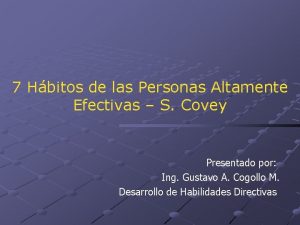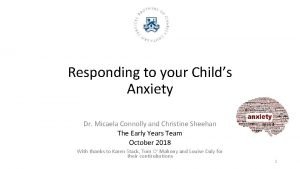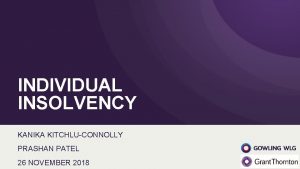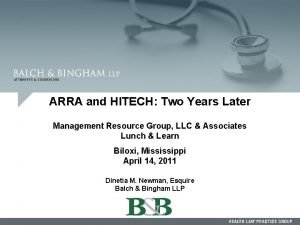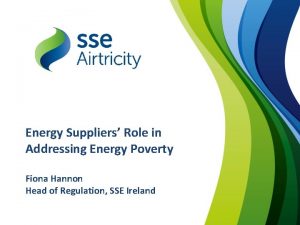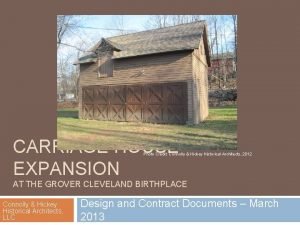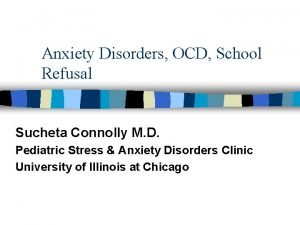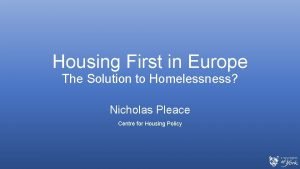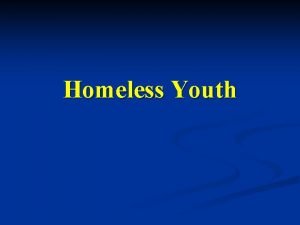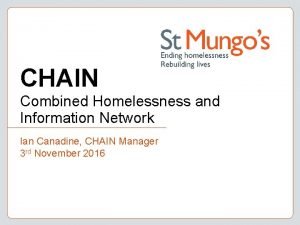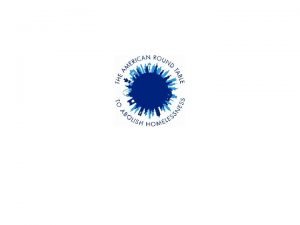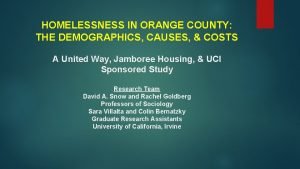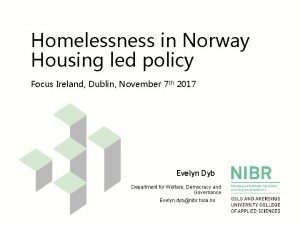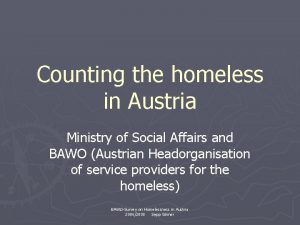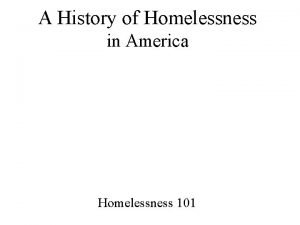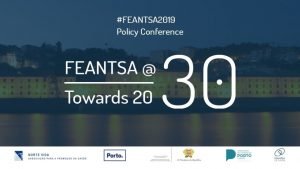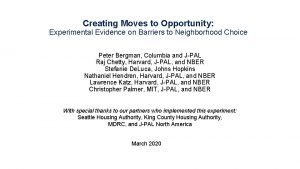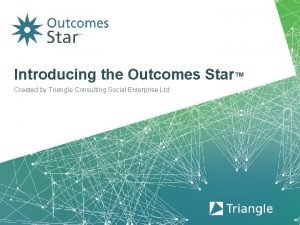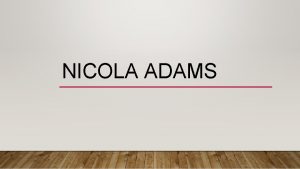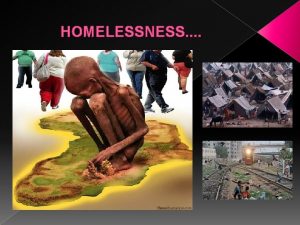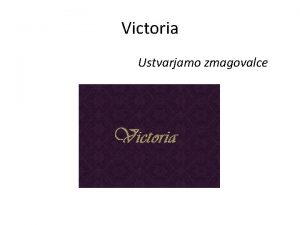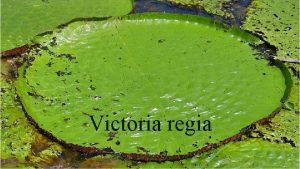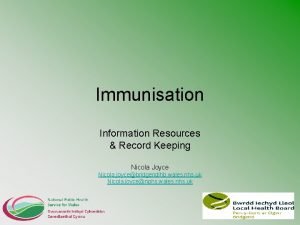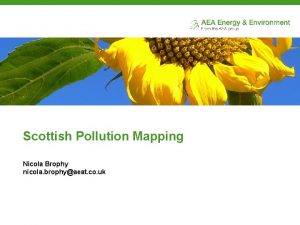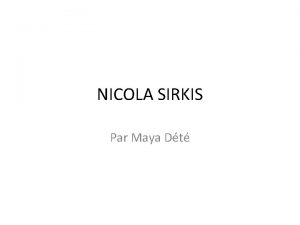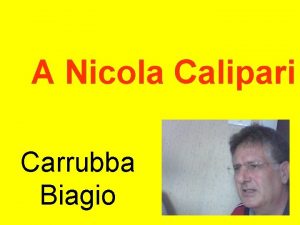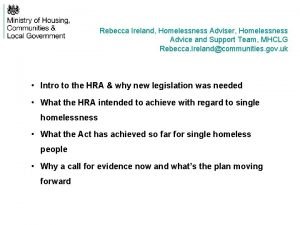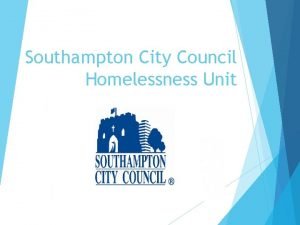The Homelessness Service System in Victoria Nicola Connolly





















- Slides: 21

The Homelessness Service System in Victoria Nicola Connolly Date 30 th July 2015

What does Launch Housing do? We work with people who are experiencing homelessness to try to assist them through many of our services. We help people to sustain their public, private or community housing. We work with government systems like public hospitals, justice and mental health services to prevent people becoming homeless when they leave these services. We also undertake research and advocate for reform to ensure that groups at risk of homelessness are identified early in mainstream systems like education, health and child protection. We currently operate across 14 sites in metropolitan Melbourne.

Program areas (Collingwood) • • Initial Assessment & Planning (crisis) Accommodation Options for Families Home. Ground Outreach Support Service (HOSS) Justice Housing Support Program (JHSP) Mental Health Support for Secure Tenancies (MHSST) Housing Mental Health Pathways Program (HMHPP) Transitional Housing Stock

IAP Aim • Initial Assessment and Planning (IAP) is the main access point for clients experiencing or at risk of homelessness throughout Victoria. It helps people prevent and end homelessness by providing accommodation assistance, advice and referrals for additional support. Eligibility • Anyone experiencing or at risk of homelessness is eligible for assistance. • Please note that eligibility for specific forms of assistance will vary depending on individual circumstances.

Initial Assessment & Planning • The IAP service in Collingwood is a drop in service for clients who are experiencing homelessness or are at risk of homelessness. • We undertake general assessments of an individual or households’ housing and support needs and personal vulnerability. Support options are discussed with clients and, where possible, immediate crisis assistance of a limited nature is provided. • We currently see between 500 & 600 clients per month at Collingwood access point.

HEF Housing Establishment Fund HEF uses: • Emergency accommodation – Rooming houses/Motels, • Private rental- rent in advance/rental arrears, • Rent in advance for public and community housing, • SRS accommodation, • Travel.

Emergency Accommodation • Emergency accommodation in Victoria is a mix of rooming houses, refuges, motels and supported accommodation. • Rooming houses are the most common type of emergency accommodation and many are not registered with their local councils. • IAP uses many of these types of accommodation for clients, however, we do not use unregistered rooming houses.

Private Rental • Median rents in metropolitan Melbourne ranged from $300 per week for the western Melbourne region to $425 for the inner Melbourne. • Vacancy rates for private rental are around 1. 4% • Launch Housing assists clients on low incomes to access affordable private rental and keep it. • Office of Housing also offers a bond loan assistance fund (zero interest & 55% of income).

Public Housing • 83, 000 Social Housing dwellings in Victoria, 65, 000 of which are public housing and 127, 000 tenants • There are 38, 244 currently on the waiting list for public housing. • 10, 544 people on the wait list are identified with support needs. • 86% of tenants are reliant on Commonwealth Government income support. • Social housing, advocacy and support programs (SHASP) support many of these tenants.

Community Housing • Community housing is an innovative housing option for any family or individual on a low to moderate income. • For those people who cannot afford a home and who pay more than 30% of their income in a private rental property, community housing is managed by not-for-profit housing organizations who act as landlords to provide long term security of tenure in quality-built homes at an affordable rental rate. • To find your nearest Community housing option go to: • http: //www. chfv. org. au/find-housing/

Transitional Housing • Home. Ground manages a pool of approx 320 transitional properties • Access to these properties are through the IAP assessment and opening doors. • Properties are short term/transitional as a stop gap to permanent housing • Access for those with support needs/worker only

How many people are homeless? According to the ABS, 105, 237 people were homeless on Census night on August 9, 2011, or 0. 5 per cent of the Australian population. 17, 845 of all people experiencing homelessness were under the age of 12, rising from 15, 715 in 2006 • In Victoria on Census Night 2011 approximately 22, 000 people were homeless. • It important to note that given the difficulty in accurately counting everyone experiencing homelessness, that the ABS and the Homelessness Sector agree that homelessness is in fact undercounted.

Key points • The number of people experiencing homelessness on Census night in 2011 increased by 17% from 89, 728 people in 2006 to 105, 237 people. • The rate of homelessness has increased from 45/10, 000 to just under 49/10, 000 people. • This means that nearly 1 in every 200 Australians was experiencing homelessness on Census night 2011. • There has been a significant increase in homelessness in NSW, Victoria, Tasmania and the ACT with overall levels of homelessness increasing by more than 20% in those jurisdictions over the 5 years to 2011.

Impacts of homelessness • Poor physical health. Being homeless can make it very difficult to access health care and seek treatment. Homelessness literally makes you sick. • Poor mental health – depression, anxiety & other serious MH conditions are often triggered or exacerbated by homelessness. • Social exclusion. • Social isolation. • Stigma. • Premature ageing.

Duration • We know from research both here and overseas that there is a direct correlation between the length of time spent experiencing homelessness and the subsequent severity of the impacts. • Basically the longer a person is homeless the more damage it causes and the longer it takes to recover. • Homelessness can have a devastating effect on children making their chances of experiencing homelessness later in life more likely.

Jack of all Trades • Clients often present with eight to ten (or more) presenting issues. • Housing is one of those needs but it’s the fundamental need that everything else hinges on. • Good outcomes are very much dependent on service providers knowledge of and ability to navigate multiple service systems to get a variety of needs met – housing, mental health, primary health, specialist health services, family and parenting services, legal, financial, cultural etc.

Victorian Service System Responses

Opening Doors is a framework of principles and practices that is intended to guide and improve client assessment, referral, resource allocation and coordination across the Victorian Homelessness Service System. It was introduced in 2008. Its broad objective is to produce more timely, coordinated and effective access to the service system for clients who are homeless or at risk of homelessness and to provide a more coordinated, client centered response from the homelessness service system. The Opening Doors Framework incorporates the following features: • A consumer focused and strengths based approach • Equity of access to the resources of the homelessness service system • Support for skilled workers with training, supervision and efficient tools • Collaboration and partnerships between agencies and the DHS • Reasonable care to address the risks faced by each person who is homeless • Maximizing the use of available homelessness resources.

What to do? People experiencing homelessness can call 1800 825 955 to talk to an Initial Assessment and Planning (IAP) staff member about their situation. When you call this number you are automatically connected to the nearest Homelessness Access Point Service. What does the IAP team at an Access Point service do? • Undertakes an initial assessment of the housing and support needs, and level of personal vulnerability, of any individual/households seeking assistance – assessments can either be in person or on the telephone. • Refers eligible individuals/households to transitional housing and homelessness support services. • Provides limited assistance to those individuals/households awaiting assistance who are assessed as being at greatest risk and for whom there is not an immediate available support vacancy. • Maintains Prioritization Lists of individuals/households awaiting homelessness assistance.

Access Points Inner Melbourne • • • Launch Collingwood – Oxford Street 9288 -9600 Launch St Kilda – Chapel St 9537 -7195 Haven Home. Safe– Mary St Preston 9479 -0700 Yarra Community Housing - Victoria Street, Seddon 9689 2777 SASHS - 2 a Settlement Road, Belmont 5244 -9560

Q & A
 Habitos de la victoria privada
Habitos de la victoria privada Micaela connolly
Micaela connolly Prashan patel
Prashan patel Fundamentals of web development randy connolly ppt
Fundamentals of web development randy connolly ppt Andrew connolly exeter
Andrew connolly exeter Connolly recovery audit
Connolly recovery audit Connolly lodge buckingham street
Connolly lodge buckingham street Connolly & hickey historical architects
Connolly & hickey historical architects Coping cat fear ladder
Coping cat fear ladder Finland homelessness solution
Finland homelessness solution Homelessness
Homelessness Youth homelessness definition
Youth homelessness definition Combined homelessness and information network
Combined homelessness and information network Michigan campaign to end homelessness
Michigan campaign to end homelessness Abolish homelessness
Abolish homelessness Causes of homelessness orange county
Causes of homelessness orange county Homelessness in norway
Homelessness in norway Homelessness in austria
Homelessness in austria Timeline of homelessness in america
Timeline of homelessness in america Definition of youth homelessness
Definition of youth homelessness The bill homelessness was
The bill homelessness was Outcome stars triangle
Outcome stars triangle
